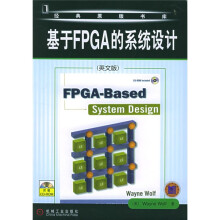Preface
Chapter 1 FPGA-Based Systems
1.1 Introduction
1.2 Basic Concepts
1.2.1 Boolean Algebra
1.2.2 Schematics and Logic Symbols
1.3 Digital Design and FPGAs
1.3.1 The Role of FPGAs
1.3.2 FPGAs Types
1.3.3 FPGAs vs.Custom VLSI
1.4 FPGA-Based System Design
1.4.1 Goals and Techniques
1.4.2 Hierarchical Design
1.4.3 Design Abstraction
1.4.4 Methodologies
1.5 Summary
1.6 Problems
Chapter 2 VLSI Technology
2.1 Introduction
2.2 Manufacturing Processes
2.3 Transistor Characteristics
2.4 CMOS Logic Gates
2.4.1 Static Complementary Gates
2.4.2 Gste Delay
2.4.3 Power Consumption
2.4.4 Driving Large Loads
2.4.5 Low-Power Gates
2.4.6 Switch Logic
2.5 Wites
2.5.1 Wire Structures
2.5.2 Wire Parasitics
2.5.3 Models for Wires
2.5.4 Delay Through an RC Transmission Line
2.5.5 Buffer Insertion in RC Transmission Lines
2.5.6 Crosstalk Between RC Wires
2.6 Registers and RAM
2.6.1 Register Structures
2.6.2 Random-Access Memory
2.7 Rackages and Rads
2.7.1 Packages
2.7.2 Pads
2.8 Summary
2.9 Problems
Chapter 3 FPGA Fabrics
3.1 Introduction
3.2 FPGA Architectures
3.3 SRAM-Based FPGAs
3.3.1 Overview
3.3.2 Logic Elements
3.3.3 Interconnection Networks
3.3.4 Configuration
3.4 Permanently Programmed FPGAs
3.4.1 Antifuses
3.4.2 Flash Configuration
3.4.3 Logic Blocks
3.4.4 Interconnection Networds
3.4.5 Programming
3.5 Chip I/O
3.6 Circuit Design of FPGA Fabrics
3.6.1 Logic Elements
3.6.2 Interconnect
3.7 Architecture of FPGA Fabrics
3.7.1 Logic Element Parameters
3.7.2 Interconnect Architecture
3.7.3 Pinout
3.8 Summary
3.9 Problems
Chapter 4 Combinational Logic
4.1 Introduction
4.2 The Logic Design Process
4.3 Hardware Description Languages
4.3.1 Modeling with HDLs
4.3.2 Verilog
4.3.3 VHDL
4.4 Combinational Network Delay
4.4.1 Delay Specifications
4.4.2 Gate and Wire Delay
4.4.3 Fanout
Chapter 5 Sequential Machines
Chapter 6 Architecture
Chapter 7 Large-Scale Systems
Appendix A Glossary
Appendix B Hardware Desscription Languags
References
Index

 缺书网
缺书网 扫码进群
扫码进群





